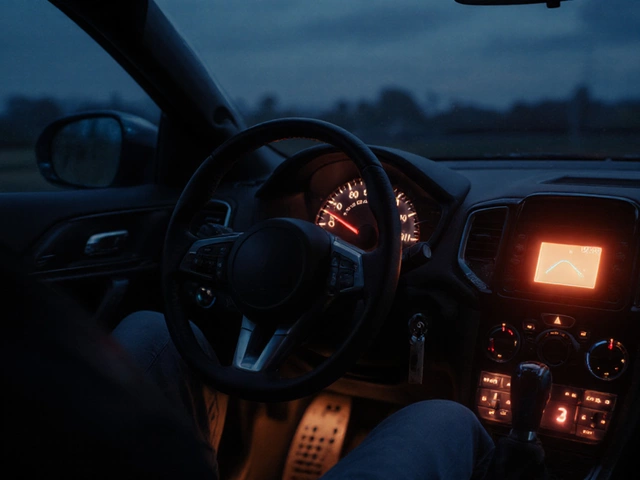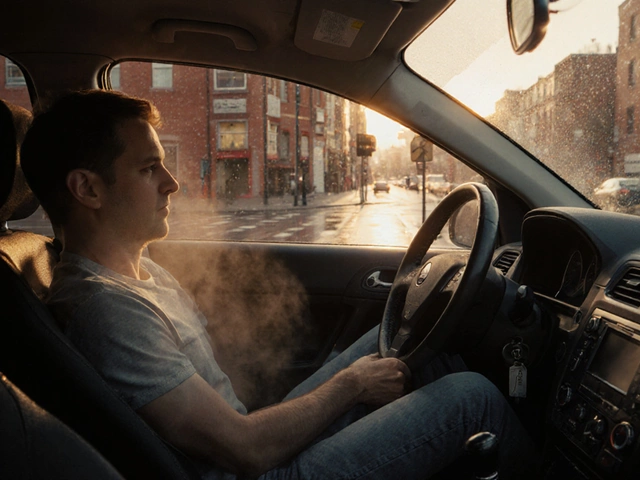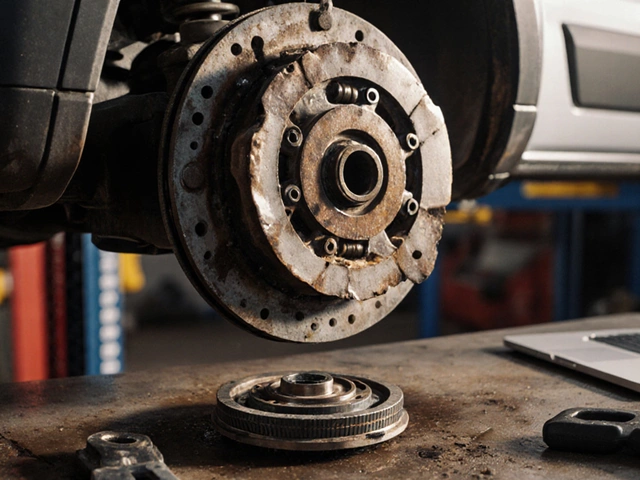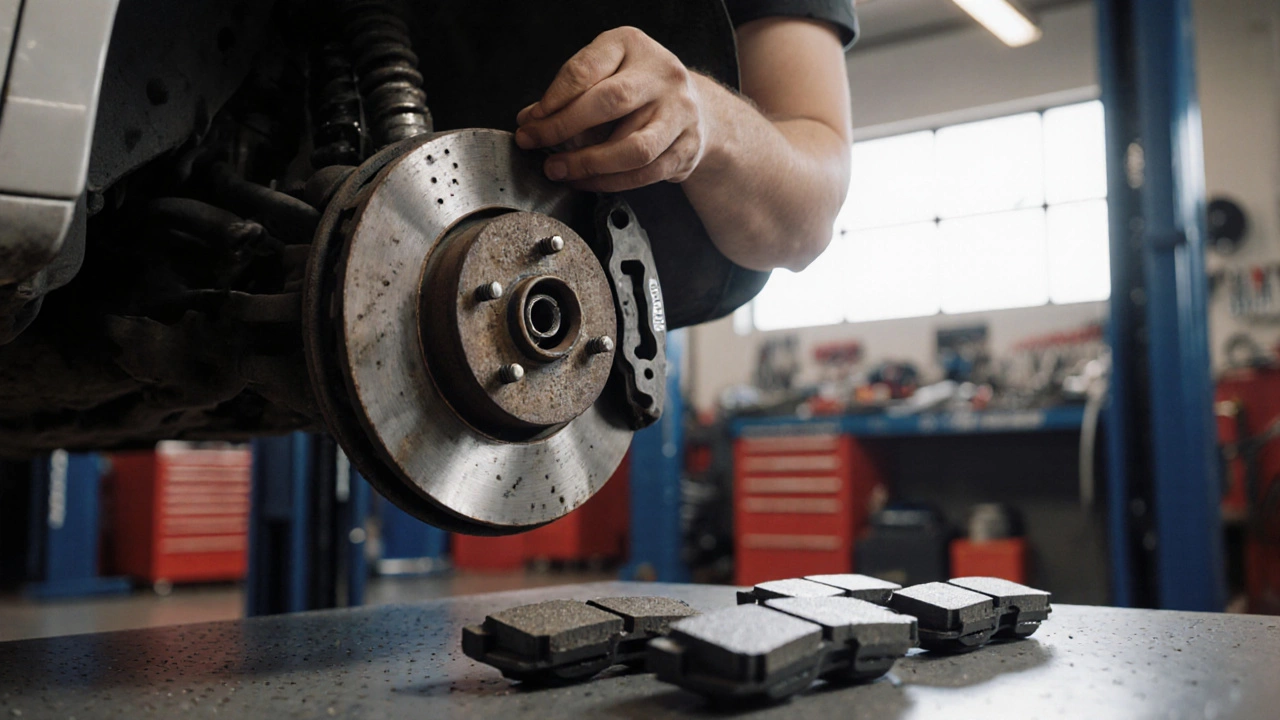
Brake Pad Replacement Cost Calculator
Estimate Your Brake Pad Replacement Cost
Replacing brake pads isn’t a mystery, but the price tag can feel like one. You hear $200 from one shop, $500 from another, and now you’re wondering: how much does it cost to just replace brake pads? The answer isn’t one number-it’s a range shaped by your car, where you live, and whether you’re buying cheap parts or premium ones. This isn’t about fancy upgrades or full brake jobs. This is about the bare minimum: pulling off the old pads and putting in new ones. Let’s break it down so you know exactly what to expect.
What’s Included in a Brake Pad Replacement?
When you say "just replace brake pads," you’re thinking about the pads alone. But mechanics don’t work in a vacuum. Even a simple pad swap involves more than sliding in new rubber and metal. Here’s what’s actually part of the job:
- Removing the wheel and brake caliper
- Inspecting the rotors for wear, warping, or scoring
- Removing the old brake pads
- Installing new pads
- Lubricating caliper slides and hardware
- Bleeding the brake system if air got in
- Testing the brakes before driving
Some shops will try to upsell you on rotor resurfacing or replacement, new calipers, or brake fluid flushes. You don’t need those unless the rotors are worn beyond safe limits or the fluid is dirty. But a good technician will check them-and tell you if they’re bad. That’s part of the service. You’re paying for labor and inspection, not just the pads.
Brake Pad Costs: OEM vs. Aftermarket
The price of the pads themselves varies wildly. A set of basic aftermarket pads can cost as little as $30. Premium ceramic pads from brands like Akebono, Bosch, or Power Stop run $80 to $150. OEM pads (the exact ones your car came with) usually cost $100 to $200 for a full set.
Here’s what you’re really buying:
- Economy pads ($30-$60): Made from semi-metallic material. Noisy when cold, wear faster, and create more dust. Fine for low-mileage city driving.
- Mid-range pads ($60-$100): Better materials, quieter, longer life. Most people get these. Brands like Wagner, Raybestos, or NAPA AutoParts.
- Premium ceramic pads ($100-$200): Quietest, least dust, longest-lasting. Best for highway driving or if you hate cleaning wheels. Used by Toyota, Honda, and Ford dealerships.
Don’t buy the cheapest pads just to save $20. Bad pads can warp rotors, cause brake fade, or even crack under heavy use. A $50 set might cost you $300 in rotor damage down the road.
Labor Costs: The Real Wild Card
Labor is where prices explode. The national average for brake pad replacement labor is $80 to $150 per axle. But that’s just a starting point.
Here’s how labor costs vary:
- Independent shops: $75-$120 per axle. These are your best bet for fair pricing. Many offer free inspections.
- Dealerships: $120-$200 per axle. Higher because they use OEM parts and certified techs. You pay for brand trust.
- Big chain stores (Firestone, Midas): $100-$180 per axle. Often run promotions like "free brake inspection," but the final price can creep up.
- DIY: $0. If you have tools and time, you can save the whole labor bill.
Some cars are harder to work on. A 2015 Honda Civic? Easy. A 2023 BMW X5 with electronic parking brakes? That’s a 2-hour job, not 45 minutes. Labor can jump to $200 just because the caliper bolts are rusted shut or the brake sensor wires are buried behind the hub.
Total Cost Breakdown by Vehicle Type
Here’s what you’ll likely pay in 2025, based on real-world data from repair databases and mechanic forums:
| Vehicle Type | Parts Cost | Labor Cost | Total Cost |
|---|---|---|---|
| Compact Car (Toyota Corolla, Honda Civic) | $50-$100 | $80-$120 | $130-$220 |
| Midsize Sedan (Honda Accord, Toyota Camry) | $70-$130 | $90-$140 | $160-$270 |
| SUV (Honda CR-V, Toyota RAV4) | $80-$150 | $100-$160 | $180-$310 |
| Truck (Ford F-150, Chevrolet Silverado) | $90-$180 | $110-$180 | $200-$360 |
| Luxury Car (BMW 3 Series, Audi A4) | $120-$250 | $150-$250 | $270-$500 |
Notice the pattern? Heavier vehicles need bigger, stronger pads. Luxury cars use more complex brake systems with sensors, calipers, and electronic controls. That drives up both parts and labor.
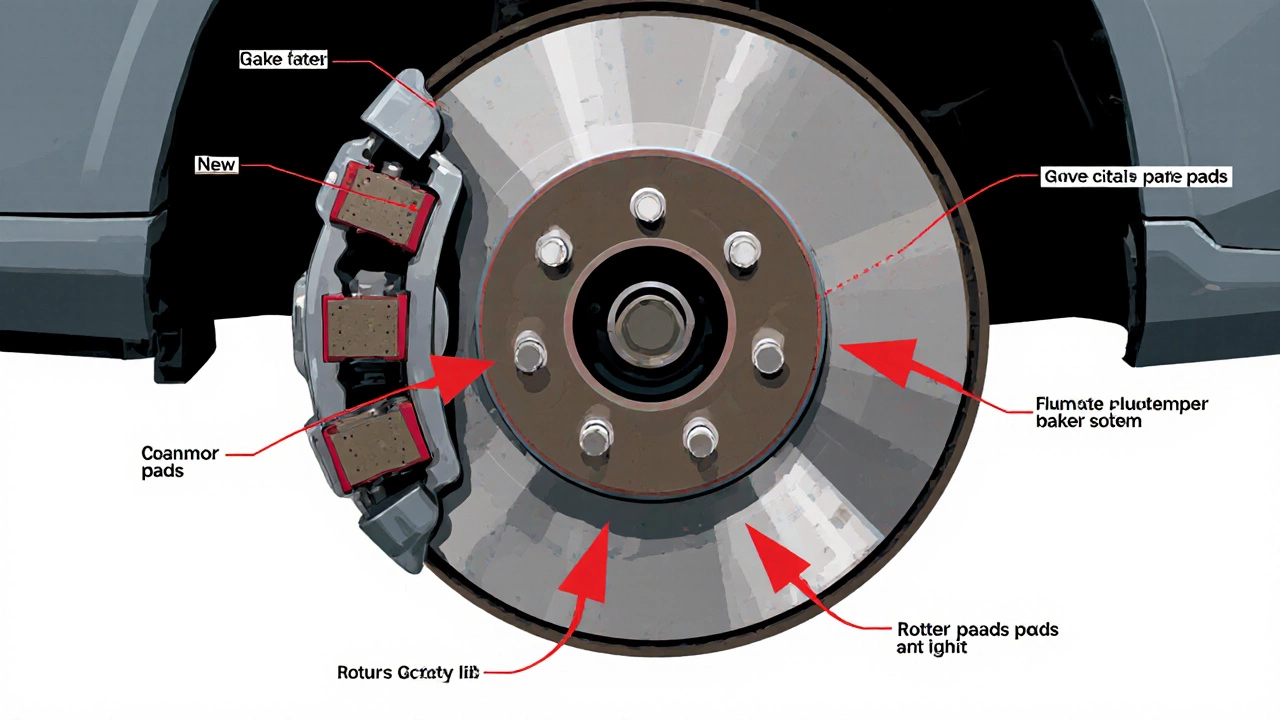
When You Might Pay More Than Expected
Here are the sneaky reasons your bill might be higher than the numbers above:
- Worn rotors: If they’re scored or thinner than 2mm, they need replacing. A new rotor set adds $100-$300.
- Brake sensors: Many modern cars have pad wear sensors. If they’re broken, you’ll pay $30-$80 to replace them.
- Caliper issues: If the caliper is sticking or leaking, you’re looking at $200-$600 for repair or replacement.
- Brake fluid flush: Not required every time, but if the fluid is dark or over 3 years old, a flush adds $80-$120.
- Location: In New York City or San Francisco, labor rates are 30-50% higher than in rural Ohio or Texas.
Always ask for a written estimate before work starts. If they say "we’ll call you if we find something," walk away. A reputable shop will tell you upfront what’s needed.
DIY: Can You Save Money Doing It Yourself?
Yes. And no.
If you’ve changed a tire and used a wrench before, you can replace brake pads. You’ll need:
- Jack and jack stands
- Socket set and torque wrench
- C-clamp or brake caliper tool
- Brake cleaner
- High-temperature brake grease
Most kits come with everything except tools. You’ll spend $60-$180 on parts. Time investment: 1.5 to 3 hours per axle. Save $100-$300 in labor.
But here’s the catch: brake systems are safety-critical. If you mess up the torque on the caliper bolts, or don’t bleed air out properly, you risk brake failure. If you’ve never done it before, watch 3 YouTube tutorials. Then do it on a weekend when you’re not rushed. Don’t cut corners.
How to Get the Best Deal
Don’t just pick the cheapest shop. Pick the smartest one.
- Get 3 written estimates. Ask for itemized breakdowns: parts, labor, taxes.
- Ask if they use OEM or aftermarket parts. If they don’t know, find another shop.
- Check reviews on Google and Yelp. Look for mentions of "no upselling" or "honest assessment."
- Ask about warranties. Most good shops offer 1-year or 12,000-mile coverage on parts and labor.
- Look for coupons. Many chains offer $20-$50 off brake services. AutoZone and Advance Auto Parts sometimes have printable discounts.
One tip: If you’re replacing front pads, do both front and rear at the same time. It’s more efficient for the shop-and you’ll avoid another visit in 6 months. Rear pads often last longer, but they wear unevenly if fronts are new and rears are old.
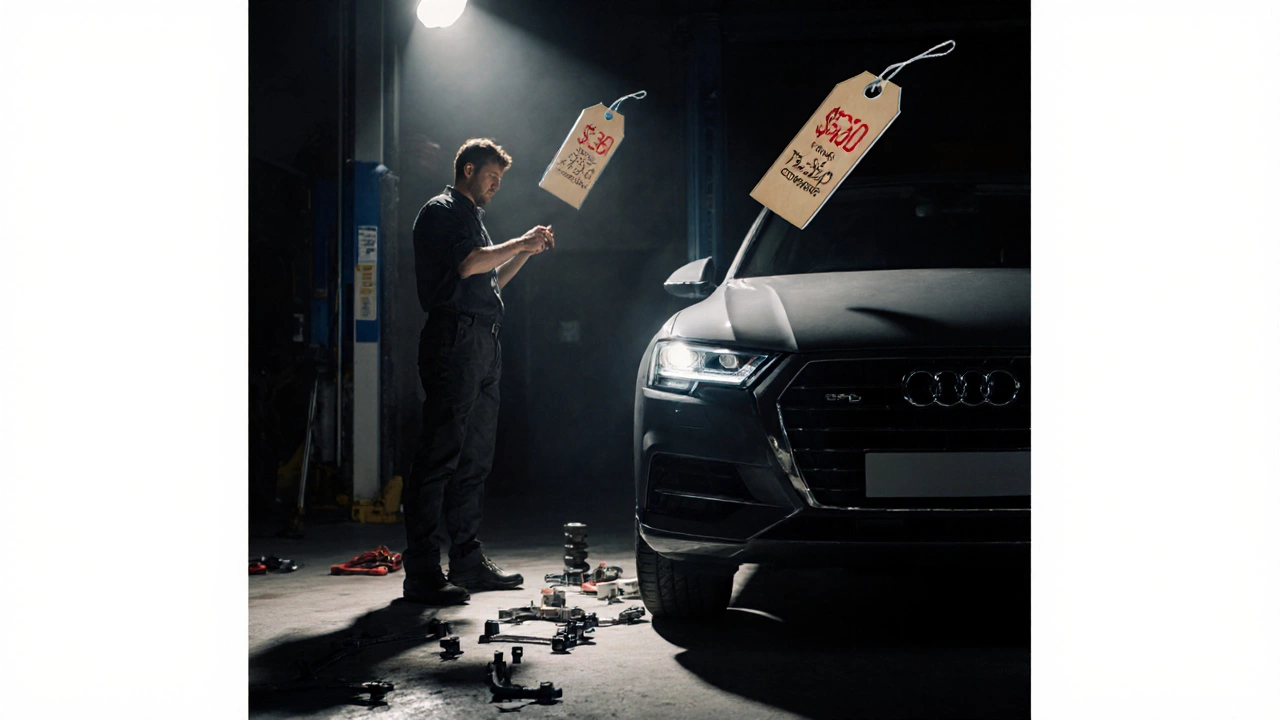
Signs You Need New Brake Pads
You shouldn’t wait until you hear squealing. By then, you’re already damaging rotors. Watch for these early signs:
- Brake pedal feels softer or sinks farther when pressed
- Car pulls to one side when braking
- High-pitched squeal when braking (most pads have wear indicators)
- Visible pad material less than 1/4 inch thick (check through wheel spokes)
- Warning light on dashboard (some cars show a brake pad icon)
Get your pads checked every 12,000 miles or during every oil change. Most shops do it for free.
How Often Do Brake Pads Need Replacing?
There’s no universal answer. It depends on:
- Driving style (aggressive braking = faster wear)
- Climate (wet, salty roads corrode metal faster)
- Vehicle weight (heavier cars put more stress on brakes)
- Pad material (ceramic lasts longer than semi-metallic)
Most drivers get 30,000 to 70,000 miles out of a set. City drivers with stop-and-go traffic might need new pads at 25,000 miles. Highway drivers can stretch to 80,000.
Don’t wait for noise. Check them regularly. A $15 inspection saves you $400 in rotor replacement.
Can I replace just the front brake pads and not the rear?
Yes, you can replace just the front pads if the rear ones are still in good condition. Most cars use the front brakes for 70-80% of stopping power, so they wear faster. But if your rear pads are below 30% thickness or show signs of uneven wear, replace them too. Mixing new fronts with old rears can cause brake imbalance and pulling.
Do I need to replace rotors when I replace brake pads?
Not always. If the rotors are smooth, even, and thicker than the manufacturer’s minimum thickness (usually printed on the rotor edge), they’re fine. Many shops try to upsell rotor replacement because it’s more profitable. Ask to see the rotor thickness measurement. If it’s above 2mm and not warped, keep them. Resurfacing is rarely worth it anymore-new rotors cost less than labor to machine them.
How long does a brake pad replacement take?
A typical front brake pad replacement takes 1 to 2 hours. Rear pads take about the same. If rotors need replacing or calipers are stuck, add another hour. Luxury or performance vehicles with complex brake systems can take 3 hours or more. Most shops offer same-day service if you drop off in the morning.
Are expensive brake pads worth it?
For most drivers, yes. Premium ceramic pads last longer, stop more smoothly, and don’t create dust that stains your wheels. You’ll notice less noise, especially in cold weather. The extra $50-$100 upfront saves you money over time because you won’t need replacements as often, and you won’t damage your rotors. If you drive mostly on highways or in cities, ceramic is the smart choice.
What happens if I wait too long to replace brake pads?
If you wait until you hear grinding, you’ve already damaged the rotors. The metal backing plate of the pad is now scraping against the rotor surface. That creates deep grooves, warping, and uneven braking. Replacing just the pads won’t fix it-you’ll need new rotors too. And if you keep driving, you risk caliper damage or even brake failure. Don’t wait. Check your pads every 12,000 miles.
Final Thoughts
Replacing brake pads shouldn’t break the bank. For most cars, expect to pay between $150 and $300. Luxury vehicles might push you to $500. The key is knowing what’s necessary-and what’s a sales pitch. Get a written estimate. Ask about rotors. Don’t rush. And never ignore a squeal. Your brakes are the most important safety system on your car. Pay a little more now to avoid a much bigger cost-or worse-later.
